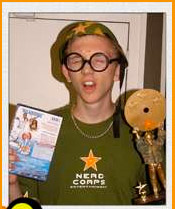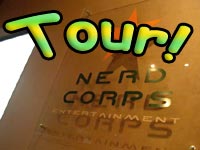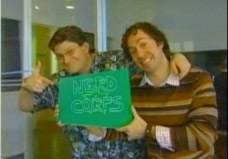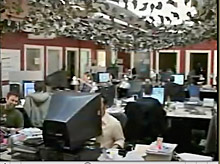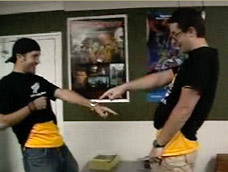Parmon's Workshop
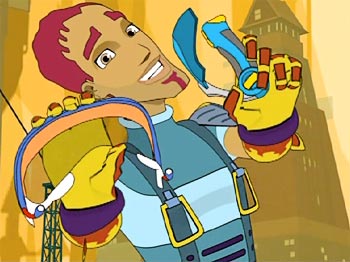 |
Play Music: Music by Bob Buckley |
Welcome to the workshop! Here, using the intricacies and extensibility of the hypertext markup language (Version 4.01 Transitional, of course) distributed to you via the Hypertext Transport Protocol layered atop a combination of the Transmission Control Protocol and the Internet Protocol, along with prodigious use of both static and full motion imagery coupled with synchronized auditory stimulation to more readily disseminate the information, Parmon has prepared and organized a prodigious amount of data concerning the development and production that occurs beyond the normal scope of the spectators but is otherwise necessary so that the computer generated imagery of the show known commonly as "Dragon Booster" can be observed by said spectators in their respective domiciles.
Umm. Well, in other words, this web page will give you a behind the scenes look at the production of Dragon Booster. (Isn't that what I just said?)
Introduction
There are three main companies involved with the production of Dragon Booster:
- The Story Hat, located in the state of Rhode Island in the United States
- Nerd Corps, located in Vancouver, Canada
- Alliance Atlantis, located in Toronto, Canada
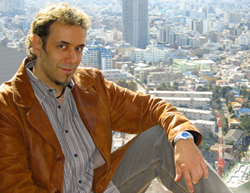 |
Rob Travalino |
 |
Kevin Mowrer |
Dragon Booster was created by Kevin Mowrer and Rob Travalino of The Story Hat. Founded on February 1, 2000, The Story Hat is a company focused on developing shows like Dragon Booster, the story line of which is based on a short story written by Kevin. Along with their creative team, Kevin and Rob created the Dragon Booster world, the characters and the overall story arc of the series.
Rob said, "Kevin showed me his premise and a world vision for Dragon Booster that just made my head explode! We both knew that this property had to be our first out the door. There was something truly epic and deeply empowering at its center just waiting to be discovered and I wanted to stand in this world as any number of possible characters to explore its history and live the hero's journey."
Kevin commented, "Rob has a real gift for character creation and for embedding and discovering powerful and relevant human mythology in every story. Where I tend to start with world and world logic, Rob tends to start from the characters and work his way outwards. It's a really amazing process because we come at properties from different angles and meet someplace in the middle. The result is deeply crafted stories where every corner of the narrative has impact on multiple levels. Rob expanded the premise and world of Dragon Booster into something classic and mythic as well as new and unique."
Rob himself serves as Story Editor throughout the series which means he oversees the writers of the individual episodes and ensures that they remain true to the overall story. Rob has also written a number of episodes himself.
Dragon Booster has fans across a wide range of age groups. Regarding this Rob said, "We did design as much of the show as possible to be broader in its psychological, social and cultural underpinnings than even Star Wars. The idea is that if you frame a concept in a structure that has deep psychological basis, i.e., (the dragon stands for personal human power) give it sociological reference, (the colors of draconium give rise to human archetypes based on power) and then frame it in a cultural sense, (the crews and factions represent how commerce, social stratification, philosophy and military/industrial all reflect the inner struggle over this power) you have a story that can relate to multiple ages. The trick was to frame it in a historical context as well, so that the story had a sense of playing out through a deep possible human reality."
Rob continues, "I can't tell you how many fans we have that are college age and above. It's the reason Toon Disney found a healthy share of viewers late at night, something I am particularly proud of. We have already written a live action feature film script that takes place before the TV series too and it explains the evolution into the present series with a few wonderful surprises. The hero of the film's name is Tannis Blayrr and he begins as a disgraced Elite Class Racer. Yes, he's Tannis the Dragon Priest but I won't tell you any more than that!"
Speaking about the fan community that has embraced the show, Kevin added, "Every creator's dream is to make something that has truth and meaning in it for someone else. As Dragon Booster progressed down the development path it quickly took on a life of it's own that began with Rob and I but became itself quickly. Our job became to protect and grow it and let the story, voice and meaning that it seemed to hold, come to the small screen (for starters). Communities are about groups of individuals coming together around a common idea. Whatever that idea is, it is kept alive at the edges not by the creators but by the community. Without you and the community we are only making a TV show."
To bring Dragon Booster to life, Nerd Corp was brought into being. Nerd Corp was a brand new company formed by Asaph Fipke (who serves as Producer of the series) for the purpose of providing all the animation and production services needed to realize the vision of Dragon Booster. Setting up base in Vancouver in the Pacific Northwest, they put together the full scale CG animation studio needed to create the show. There they attracted some of the industry’s most experienced talent and rising stars to join Nerd Corps for this project. Their choices in the animation, art style and feel of the show were made to maximize the emotional and visual impact of the stories and blend elements of anime, classic 2D animation, 3D technology and film making into a powerful new approach.
Since completing production on Dragon Booster in the spring of 2006 when episode 39 was finished, Nerd Corps has moved on to new projects, the most exciting of which to Dragon Booster fans is a new show titled "Storm Hawks" which will premiere in 2007 in Canada and the United States.
Finally, Alliance Atlantis is a strategic partner with The Story Hat that, among other things, provides licensing and distribution services. Their association with The Story Hat began in 2002 at a licensing show New York. They are the ones that help make the deals to get Dragon Booster on TV in countries around the world and handle the licensing for toys and other merchandise. Kevin Faier, who is an Executive Producer of Dragon Booster and with Alliance Atlantis at the time said, "The Story Hat has been a great partner to work with on every level. We share Kevin and Rob’s belief that great commercial success must come not only from a well thought out strategy but more importantly from great creative content. Dragon Booster has all of these qualities."
More background information can be found here ->
More behind the scenes information from the show's creators is waiting for you in The Dragon Temple ->
The Computer Animation Process
Dragon Booster is an all computer animated series, the basic process of which is similar to that used to create feature length computer animated movies such as "Toy Story" and "Shrek", though of course Dragon Booster has its own unique look. The shading they use flattens the look of the characters to appear more like traditional 2D animation, but all the characters and much of the sets are fully modeled in 3D.
A primary benefit of 3D modeling is that it frees up the camera, allowing it to be placed at any angle and moved freely throughout the modeled environment. This makes all sorts of elaborate camera moves possible, including zoom and focus effects, along with interesting camera perspectives that would be difficult to achieve with traditional 2D hand drawn animation. For example, it's relatively easy to establish a shot where the camera tracks characters during a race. Plus various camera effects are possible. You may have noticed that the camera "shakes" when an explosion occurs or when a dragon runs past the camera. The end result this produces is a very cinematic feel to the show and a much greater sense of depth which enhances the overall visual experience.
 |
As with all animation, the process begins with the script. Without a story, there's nowhere to go. When the script for an episode is complete, it's handed off to the Storyboard Artists. These are the first people to visualize the script by making a series of drawings that represent the individual shots that will eventually be animated. These are much like the panels in a comic book, and help determine everything from what camera angles and tracking moves will be used, to the blocking of where the characters will be placed in a scene and how scenes will be staged. The storyboard is the first step in bringing the script to life and it acts as a reference point for the rest of the production process.
Design is the process where the look of new characters, props, set pieces and so on are created. Colors and shapes are determined here along with how things like props will operate. All characters, props and so forth begin as 2D drawings.
Once the designs are approved, characters, props and main set pieces have to created in the computer in 3D before they can be animated. This phase is called Modeling and it involves creating the three dimensional shapes that make up a character or prop, along with applying the texture, color and appearance of the object being modeled. Characters and props that move in some fashion have to be Rigged which is the process of taking the model and adding information on how it moves. This establishes the location of joints as well as things like the parts of a character's face that will move (most notably the mouth and eyes). Think of a 3D character model like a marionette and the rigging process is like attaching the strings which will determine how the marionette will move. The modeling process also includes defining how a model might change shape as it moves.
Each separate movement that a model is capable of making is controlled by an articulation variable, or avar for short. A model's avars are then manipulated by an animator to achieve the performance of the character. For characters, there are an enormous number of avars. Every single joint will have an avar, plus in order to get enough nuance in the facial expressions of the characters, there may be hundreds of individual avars to control all aspects of a character's face. Think about all the subtle movements in a character's eyes, eye brows, mouth and lips that are needed to express a wide range of emotion and you can see that quite a bit of detailed control is needed.
 |
Shaders are created which define the look of a model and how light will reflect off it. For Dragon Booster, a technique known as cel shading is used. In traditional 2D hand drawn animation, the characters on each frame are painted on a clear cel which is then placed over a background and photographed. The paint on the cel creates a very smooth look to the surface of the character, and the process of cel shading in CG animation replicates that look to a degree. So rather than the extra sense of depth you get on the characters in a movie like "Toy Story" which is created by the shaders being used, cel shading tends to flatten out the look of the characters to create a distinctive, stylized look that's more akin to that seen in anime.
In addition to characters, sets and props need to modeled as well. Basically, anything that the camera will need to move around will need to be modeled in 3D. For Dragon Booster, this means all the gear is modeled in 3D as well as the race tracks and buildings and other areas that the characters will be moving around in. Distant objects, such as buildings in the skyline, do not have to be modeled. Since the camera won't need to move around them, they can be represented as 2D pieces of artwork (sometimes referred to as matt paintings). Also, if you look careful at distant shots of the grandstand by the race track, you may notice that the people in the stands appear as flat 2D objects that don't move. Making them sort of like cardboard cut-outs is a useful time saving technique for non-essential background imagery.
Layout is the process of taking the initial visualized scenes from the storyboard process and defining the location of the characters on the set as well as defining the camera positions and moves that will used. This establishes how the scenes are staged and defines what the audience will eventually be seeing.
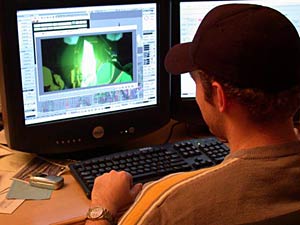 |
Once the models are fully defined and rigged, they can be passed on to Animation. The animators take the models and meticulously adjust the avars in order to achieve the needed performance. The computer can help a bit to smooth out transitions of movement and to repeat movements (such as when walking), but the important parts of the performance, such as the facial expressions, need to be animated by hand frame by frame. Any scenes that require special effects are given to an effects animator who creates the effect and how the effect moves.
Lighting defines the light sources in the scene, their color and characteristics. Numerous lights are typically used to get just the right effect and possibly to cast dramatic looking shadows.
Scenes are then sent out for Rendering. Rendering is an automated process where a computer program (known as the renderer) takes the 3D model information, the avar settings for a particular frame, the sets and background elements, the position of the camera, special effects, lighting information and so on, and generates the final full color image for that particular frame. This computationally complex process process is then repeated for every frame in the episode, and since there are so many frames to render, it can take quite some time. Click here to learn more about rendering.
Computer Animation Tools
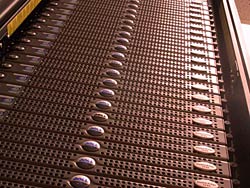 |
Nerd Corp uses a number of industry standard tools to create Dragon Booster. For animation software, they use a package called SoftImage. This is a complete animation system that can handle everything from modeling to animation, lighting, shading, rendering and so on. They also use Adobe Photoshop for creating 2D artwork for design work, backgrounds, textures and so forth.
Fans interested in learning more about 3D animation will be happy to know there's a lot of documentation available on the SoftImage web site, along with a free trial version of the software. There are also substantial discounts on the software for qualified students and teachers for anyone who's interested in a career in computer animation.
Computer hardware is provided by Dell computers. Dell computers are used for animation workstations and for the servers that perform the rendering process. SoftImage can run on Linux, and Nerd Corp uses this operating system where possible.
Renaissance of the Nerds
|
The talented people at Nerd Corps are unabashedly proud their own nerdiness. However, these are nerds for the modern age, having shed their pocket protectors and thick rimmed glasses. “We’re more like neo-nerds,” says Chuck Johnson, Dungeon Master (or Senior Vice President of Production for those not accustomed to nerd titles) at Nerd Corps. “We've got the same enthusiasm and affinity for technology, but we’re more comfortable and more accepted than our earlier versions. We really represent the evolution of the nerd in a lot of ways.”
Their passion for technology has served them well. It enabled them to get up and running quickly with a full scale production environment. “It started with just Ace (Asaph Fipke) and I and a handful of very talented nerds," remembers Chuck. “One of our primary objectives was to figure out the most efficient 3D animation pipeline that would still allow the creative process to flow freely. Our initial pipeline test came in January 2003 when we used SOFTIMAGE|XSI to create a two-minute trailer for Dragon Booster."
Fans can view this original trailer in the Dragon Temple section of this web site, or by clicking here. Observant fans will notice that Beau's character model is colored slightly differently than he appears in the show itself and that Artha's not wearing his racing jacket yet. Still, the quality and stunning visual impact of this early animation test shows how quickly they mastered the technology.
Click the link below for an article that talks in more detail about how Nerd Corps got up and running, and about how they make use of the features in SoftImage to realize the vision of Dragon Booster:
Nerd Corps Gets Busy On Dragon Booster ->
Take a Tour of Nerd Corps
| Now that you've learned a little bit about the process, are you ready to go behind the scenes and look around the production facilities at Nerd Corps and watch the talented people there work on Dragon Booster? Well then, you're in luck because Nerd Corps has a virtual tour you can take. Just knock on the door (click the image to the right) to gain entrance and begin your tour! |
|
Lending Voice to the Characters
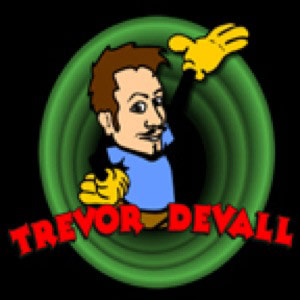 In addition to the animation itself, it is of course the voice actors that bring the characters of Dragon Booster to life. Having just the right voice for each character that expresses that character's personality and emotions is a critical element in achieving the suspension of disbelief in animation. Most of the voice cast for Dragon Booster lives and works in Vancouver, British Columbia, Canada, which is also the home of Nerd Corps. Vancouver has become a major city for voice over work, and many anime series that come to North America are dubbed into English here. If you watch the credits on your favorite anime series, you will see the names of many of the voice actors that worked on Dragon Booster.
In addition to the animation itself, it is of course the voice actors that bring the characters of Dragon Booster to life. Having just the right voice for each character that expresses that character's personality and emotions is a critical element in achieving the suspension of disbelief in animation. Most of the voice cast for Dragon Booster lives and works in Vancouver, British Columbia, Canada, which is also the home of Nerd Corps. Vancouver has become a major city for voice over work, and many anime series that come to North America are dubbed into English here. If you watch the credits on your favorite anime series, you will see the names of many of the voice actors that worked on Dragon Booster.
An excellent way to learn more about the field of voice over work and learn a little about the voice actors themselves is to listen Trevor Devall's podcast series called Voiceprint. Trevor of course provides the voice for Moordryd in Dragon Booster, and in each episode of the podcast he interviews other voice talent in the Vancouver area. They talk about their experiences working on various shows, and of course joke around a lot. The podcasts are available on Trevor's web site or by subscribing to them on iTunes:
Visit Trevor Devall's web site ->
Subscribe to Voiceprint on iTunes ->
The Music of Dragon City
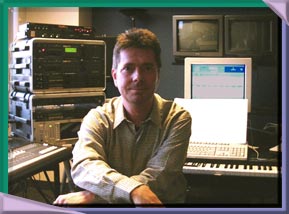 |
Music plays an integral role in the viewing experience. The most important thing about any musical score is that it must blend with and enhance the visuals on screen without being so noticeable that it distracts the viewer from the story. To get just the right sound for Dragon Booster, the producers turned veteran composer Bob Buckley. Born in Brighton, England, Bob took up the piano at age 10 and began composing almost immediately. During his career, Bob has worked professionally as a composer, arranger, performer, producer and conductor, and has composed theme music for television series and specials, commercials, audio-visuals, dance, musicals, symphonic works and films. In the animation arena, Bob has worked on several notable shows including Reboot, Transformers: Beast Wars and Transformers: Beast Machines. It is safe to say the show would not be the same without his music.
Visit Bob's web site to learn more about him and to hear samples of his music. The music you heard when you entered this page was composed by Bob.
Visit Bob Buckley Productions ->
The Screening Room
The following videos will help you learn more about Nerd Corp and the production of Dragon Booster. You'll get to meet some of the people that bring the episodes to life and see where they work.
Click the image to watch the corresponding video.
Nerd Corps on Urban RushThe Urban Rush morning TV show in Vancouver did a segment on Nerd Corps featuring Asaph Fipke and Chuck Johnson. Asaph serves as Producer of Dragon Booster and Chuck serves as co-Producer. Learn a little about the company and the production of Dragon Booster in this video. |
|
What Defines a NerdSee the production environment at Nerd Corp and learn a bit about what it means to be a Neo Nerd. |
|
The Nerd HandshakeLearn the secret handshake used by nerds. In this video clip, the nerds make reference to the major stages of the CG animation production pipeline including design, modeling, animation, special effects and on-line. |
The above videos are the property of Nerd Corp and are provided here as a convenience for fans wishing to know more about the company. The photos and quotes appearing here are from the web sites for The Story Hat, Nerd Corps, SoftImage and Bob Buckley Productions. They are used here without permission for the sole purpose of offering eager fans a glimpse behind the scenes by bringing all the information scattered about the web together in one place and to help promote the show. The music that plays on this page is the property of Bob Buckley. No copyright infringement is intended.
All Dragon Booster characters and related logos are the property of The Story Hat. Read the full notice here. Please report broken links and errors to the webmaster . Unless otherwise noted, all text appearing on this web site as well as all non-character based design elements are Copyright © 2005-2007 by Curt Schimmel.

